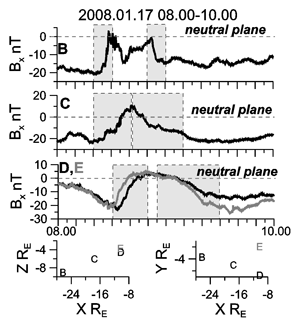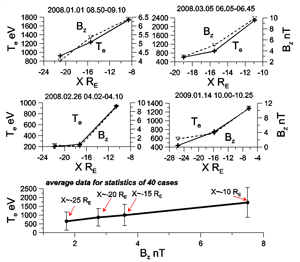
2013 THEMIS SCIENCE NUGGETS
THEMIS measurements of electron energization in the magnetotail
by A. V. Artemyev, Space Research Institute (IKI), Moscow
Introduction
Cosmic plasma systems like planetary magnetospheres are filled with warm plasma populations whose energies are substantially greater than energies of the stellar wind’s initial matter. Mechanisms of plasma energization inside the magnetosphere have been extensively studied since the first spacecraft missions revealed the thermal plasma population in the near-Earth environment. Despite many transient short-scale mechanisms, plasma heating in the course of large-scale convection motion is one of the most general ways to accelerate charged particles. This mechanism originates from the interaction of stellar wind and planetary magnetospheres. The interaction generates an electrostatic dawn-dusk field responsible for plasma convection; theoretical models of plasma heating caused by this field are well developed. However, experimental investigation of such nonlocal plasma energization requires that the principle of “being in many places in one time” is satisfied, i.e. one should measure plasma and magnetic field characteristics simultaneously in different locations inside the magnetosphere. Such a unique opportunity was recently provided by the THEMIS mission.
Results
The theory of plasma energization in the course of earthward convection is based on classical acceleration mechanisms – Fermi and betatron accelerations. For a typical magnetic field configuration in the planetary magnetotail region, the theoretical model gives the simple relation between plasma energy and the magnetic field amplitude measured in the neutral plane of the magnetotail. In the Earth’s magnetotail, both Fermi and betatron mechanisms are expected to operate well for electron energization. Fast and magnetized electrons gyrate around and oscillate along magnetic field lines and slowly drift toward the planet due to plasma convection. The kinetic energy of directed electron motion is much smaller than their thermal energy and, as a result, the electron energization corresponds to electron temperature increase. If this increase is driven by Fermi and betatron mechanisms, the electron temperature should increase proportionally to the growth of magnetic field amplitude towards the Earth. However, to prove such a simple relation one needs to measure both electron temperatures and magnetic field amplitudes simultaneously in several locations along the magnetotail. Being an impossible to accomplish task for many years, this problem becomes solvable with the successful launch of the THEMIS mission.
| Figure 1. An example of Bx component of the magnetic field measured by four spacecraft. The grey color indicate two crossings of the neutral plane. Also spacecraft positions are shown. For details see Artemyev et al. 2013. |
The orbit of the THEMIS mission assumes that five spacecraft regularly line up along the magnetotail (along the Earth-Sun axis, X). If conditions are favorable and there are large-scale flapping oscillations of the magnetotail, all spacecraft can cross the neutral plane (the center magentotail region) almost simultaneously within a thirty minute interval. Spacecraft proximity to this region is defined by measured values of the Bx component of the magnetic field – if the Bx amplitude is less than 10 nT then the spacecraft is within the neutral plane. An example of four spacecraft simultaneously crossing the neutral plane is shown in Fig. 1. The most distant spacecraft, THEMIS-B located at -27RE downtail, crossed the neutral plane Bx ~10 minutes before THEMIS-C located at -18RE downtail (RE is the Earth radius). Then, in five minutes THEMIS-D and THEMIS-E crossed the neutral plane at -11RE. Thus, we have almost simultaneous measurements of the magnetic field amplitudes at the neutral plane, Bz, and the electron temperature, Te, at three different locations along the tail. Two years of THEMIS operation in the magnetotail provide us with an opportunity to gather a series of statistics of such fortunate observations of Bz and Te at three different locations.
Several examples of Bz and Te profiles along the tail are shown in Fig. 2. There is a surprisingly precise correlation between Bz (X) and Te (X) profiles. The electron temperature (energy) grows almost linearly with the growth of magnetic field amplitude at the neutral plane in astonishing agreement with the theory.
| Figure 2. (a) Profiles of the electron temperature Te (shown by solid lines) and the magnetic field Bz (shown by dotted lines) along the tail. Data are averaged over the close vicinity of the neutral plane (|Bx|<10 nT) and shown for four examples. (b) The electron temperature as a function of Bz for all statistics of 40 events with simultaneous crossings of the neutral plane by at least three spacecraft. For details see Artemyev et al. 2013. |
Conclusion
We have demonstrated that the energization of electrons in Earth’s magnetotail behaves accordingly with the theory of plasma adiabatic heating by Fermi and betatron mechanisms. Various transient processes can be left for further investigation of high-energy particles acceleration, while the formation of the thermal electron population can be explained by the quasi-stationary convection process.
Reference
Artemyev A.V., A.A. Petrukovich, R. Nakamura, L.M. Zelenyi. Profiles of electron temperature and Bz along Earth’s magnetotail, Ann. Geo., 2013, V. 31, pp. 1109–1114, doi: 10.5194/angeo-31-1109-2013.Biographical Note
Anton Artemyev is a postdoctoral researcher at the plasma department of the Space Research Institute at Moscow, Russia. His recent interests include 1) ion dynamics in strongly curved magnetic fields and resonant ion acceleration in the magnetotail, 2) kinetic theory and spacecraft observations of current sheet structure and dynamics, and 3) electron scattering and acceleration in the Earth’s radiation belts.
 Please send comments/suggestions to
Emmanuel Masongsong / emasongsong @ igpp.ucla.edu
Please send comments/suggestions to
Emmanuel Masongsong / emasongsong @ igpp.ucla.edu


